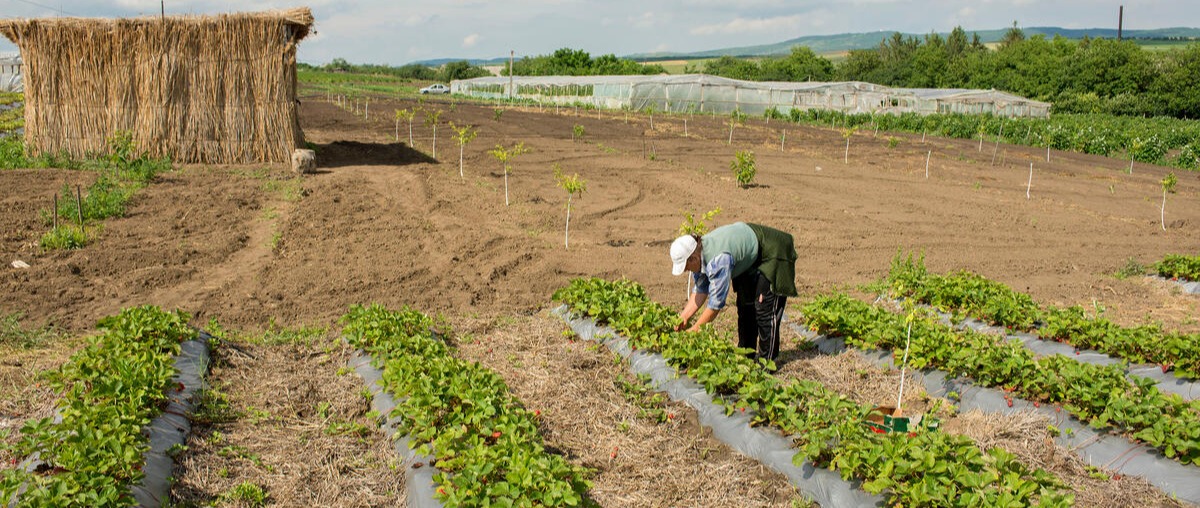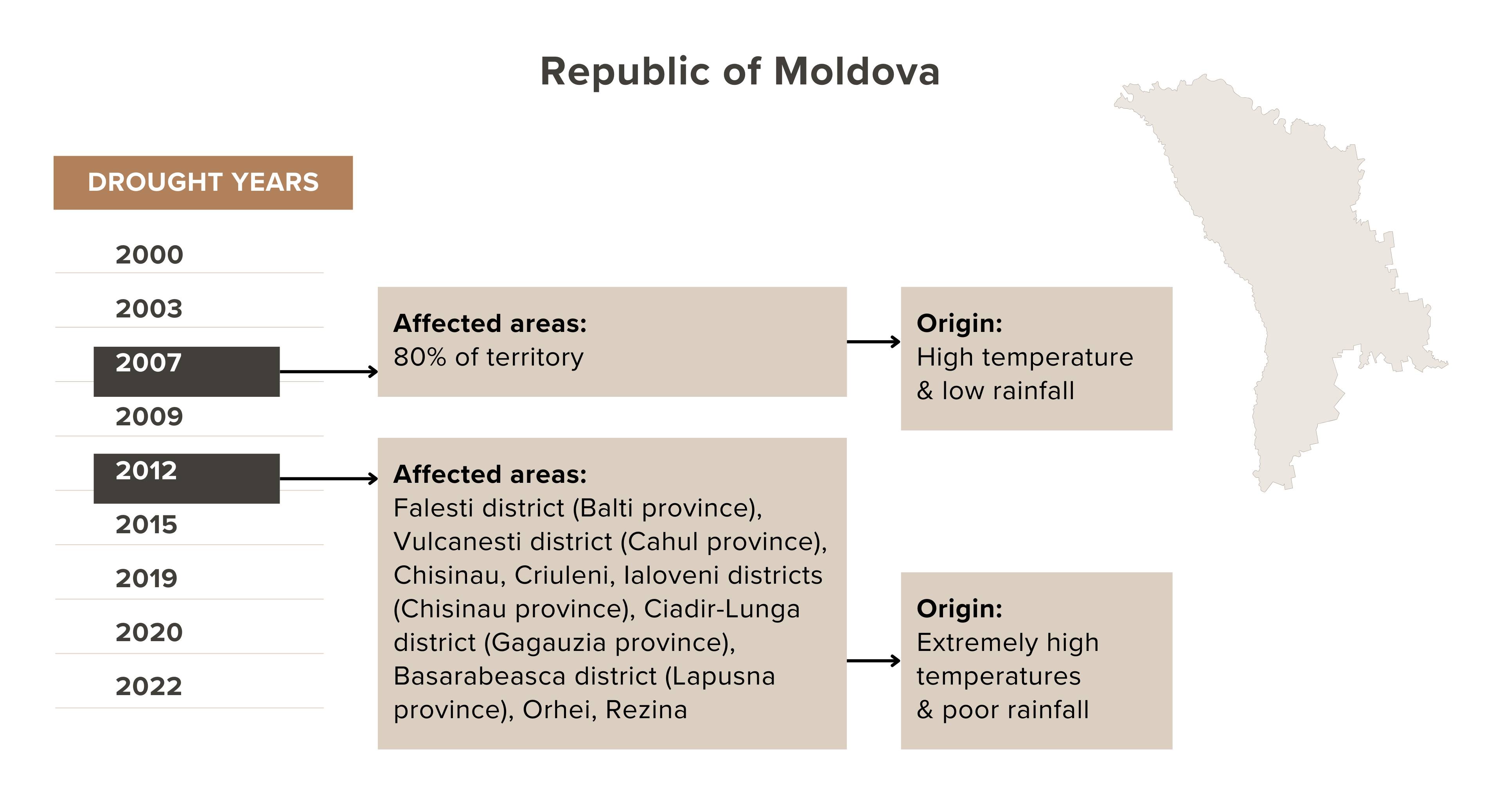
Moldova
HISTORICAL DROUGHT – The Republic of Moldova is a landlocked, middle‑income economy country in Europe. It shares borders with Romania and Ukraine and was previously part of the ex-Soviet Union. It gained its independence on 27 August 1991. Drought is a serious threat to Moldova, comprising 13% of the total number of hazards experienced by the country. Historically, Moldova has experienced drought once every 3 to 10 years, depending on geographic location.
High deficiency and high variability in precipitation are the key causes of drought in the country. Based on records dating back to 1946, the first two decades of the 21st century, 2000–2022, registered most of the driest periods in Moldova. Extreme drought was recorded in 2007, severe drought in 2012, and severe drought in 2022. The drought of 2007 was the driest year in the history of Moldova, with a return period of more than 200 years.

DROUGHT IMPACT PATHWAY – Drought has serious economic, social, and environmental impacts in Moldova. It affects the national agriculture, manufacturing, and export sectors, and has a critical effect on the overall performance of the economy. Severe and prolonged drought events likewise have dangerous impacts on the welfare of the general population, in terms of food security, health, and sanitation. The welfare of those living in rural areas and those engaged in agricultural activities are particularly affected as job losses are experienced in agriculture. Income, expenditure, and savings levels of agricultural households are affected, thereby impacting household consumption decisions.

Highlights of drought vulnerability dimensions
- 3.6 million resident population.
- 95 700 registered Ukranian refugees (as of October 2022).
- 58% of population lives in rural areas.
- Has large-scale out-migration, mostly from rural areas (95%).
- Poverty rate is 25.2% (2019), & poverty is concentrated in rural areas (around 80%).
- Poor & non-poor in rural areas rely more on agriculture & remittances for income sources than their urban counterparts.
- Most of the country’s poorest households are the backyard producers and small farmers.
- Household backyard farming & small-scale farms have limited or no access to loans & government subsidies.
- Backyard producers & small farmers lack knowledge on production technology & use of agriculture inputs, such as fertilizers.
- Agriculture comprises 27%–39% of the Regional Gross Domestic Product of the North, Center, South and T.A.U. Gagauzia regions.
- About a quarter of country population is employed in agriculture.
- Informal employment is predominant, especially in smallholder farming.
- 70% of the population from rural areas depends on agriculture for livelihood.
- 98% are small-scale, with farm sizes ranging between 0.85 and 10 ha.
- Households’ backyard farming and smallholders substantially contribute to national food security by producing a large share of important agriculture products (e.g. milk, forage crops, eggs, cattle & poultry for slaughter).
- Agro-food exports account for roughly 50% of the country’s total exports.
- Agriculture sector accounts for up to 33% of the GDP in the South Region.
- Production of food industry accounts for 35% of total manufacturing industry.
- 37% of women employed compared to 42% of men.
- On average, women earn only 87% of the male wage.
- 36% of total agricultural holders are women.
- Women manage only 19% of the land covered by agricultural holdings.
- Women’s holdings own less than 12% of the total number of farming machinery.
- 45% of the population in rural areas rely on wells as main source of drinking water.
- 44% of the population does not have access to safe drinking water.
- Has 12 000 springs & wells (public and private) & more than 3 000 functional artesian wells.
- Has 3 500 small and medium reservoirs and ponds for irrigation purposes, flow regulation and fishing.
- 90% of agricultural production is rain fed.
- most widespread irrigation system in the country is by canals and sprinklers.
- In 2021, total area equipped for irrigation was around 11% of the arable land & 4.7% percent of permanent crops.
- Newly established intensive orchards have drip irrigation.
- About 75% of territory is dry, subhumid & semiarid lands, with high frequency of drought events.
- South region is hot and arid & experienced 5–6 droughts in 10 years.
- Has high rate of land degradation especially in pasture lands.
- About 75.5% of territory under high risk of degradation processes.
- Agricultural activities cover about 74% of the landscape area.
- 80% of agricultural lands is situated on slopes.
- Soil fertility is gradually worsening due to intense soil tillage, inadequate crop rotations and poor landscape management.
- Main natural ecosystems: forests (10.8% of total area), steppe (1.9%), rocky habitats (0.68%), & aquatic (2.8%).
- Has 60 natural lakes.
- Lacks interconnecting forest corridors to support viability of the forestry fund, maintain biological diversity, conserve soils & provide hydrologic protection.
- Sub-surface waters are the main source of potable water supply of 65% of population.
- Moldova developed a National Drought Plan in 2019 (NDP) to improve drought risk management
- Institutional laws and regulations related to water, drought, and drought risk management, disaster risk reduction, climate change: Water Law (Parliament of Moldova, Law Nr. 272); Government Decision no. 779 of 04.10.2013 (Regulation on drought management planning), Law on Civil Protection, Law on water supply and sanitation no. 303 of 13.12.2013
- Plans related to drought risk management, disaster risk reduction, climate change: National Strategy for Water Supply and Sanitation for 2014-2028, Environmental Strategy for 2014-2023 and its action plan, National Strategy for the Adaptation to the Climate Change till 2020
- Government agencies relevant to drought risk management: Republican Commission for Emergency Situations, Ministry of Agriculture, Rural Development and Environment, State Civil Protection and Exceptional Situations Department (SCPESD), State Hydro meteorological Service, Institute of Ecology and Geography, “Apele Moldovei” State Agency, State Forestry Agency “Moldsilva”
- Emergency Commissions create emergency preparedness and response plans; district and local emergency commissions and the SCPESD create five-year local preparedness and response plans.
- Protocols for water–related hazard exist, from issuance of warnings, to communication and coordination of central and subnational agency activities for prevention, mitigation, rescue and relief operations
Centre for Research on the Epidemiology of Disasters. 2024. In: Emergency Events Database EM-DAT. [Cited 2 April 2024]. https://www.emdat.be/
Daradur M., Cazac V., Josu V., Leah T., Lopotenco V., Rajendra P. Pandey, Shaker R., Talmac I., Caisin V., & Isac, A. 2019. National Drought Plan of the Republic of Moldova. Ministry of Agriculture, Rural Development and Environment of the Republic of Moldova.
FAO. 2022. Special report − FAO Crop and Food Supply Assessment Mission (CFSAM) to the Republic of Moldova. Rome.
National Bureau of Statistics of the Republic of Moldova. 2024. In: Statistica Moldovei. Chisinau. [Cited 8 April 2024]. https://statistica.gov.md/en
Schwartzstein, P. 2023. History Lessons: Can Moldova Offer Clues to Future Climate Migration in Europe? Wilson Center. [Cited 3 April 2024]. https://www.wilsoncenter.org/article/history-lessons-can-moldova-offer-clues-future-climate-migration-europe
World Bank. 2016. Climate-smart agriculture in Moldova. CSA Country Profiles for Africa, Asia, Europe and Latin America and the Caribbean Series. Washington D.C., World Bank.
World Bank. 2020. Strengthening Moldova’s Disaster Risk Management and Climate Resilience Facing Current Issues and Future Challenges. Washington, DC., World Bank.
FOCUS on Vulnerability
Economic sectors: Agriculture, manufacturing, exports
Social groups: Agricultural households and communities, backyard farmers, workers employed in agriculture, women in agriculture, rural population, poor people, refugees
Geographical areas:
The whole southern region, including rural areas in the North, Center, and T.A.U. Gagauzia regions; pasture lands, agriculture lands situated in slopes, farms, and orchards without irrigation, areas with only wells as a source of drinking water
